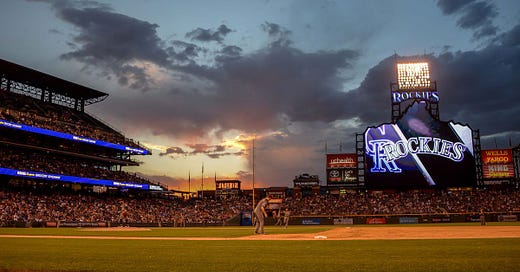Average aStuff+ by Park and Hitter Leaderboards
Analyzing the impact that altitude and environmental effects have on pitch quality.
Over the past week, I have written a couple of articles for Pitcher List discussing park factors and the impacts that they can have on in-game performance. One article focused on determining why the Seattle Mariners have experienced difficulty in acquiring impact offensive players in recent seasons, while the other article focused on evaluating Whiff Rates grouped by pitch classification at each Major League ballpark to identify potential trends that might cause park factors to influence certain outcomes.
This research reminded me of the final section of my recent article, Introducing My Stuff+ Model, where I mentioned that aStuff+ is not adjusted for altitude or environmental effects, indicating these factors might have a factor in grading pitch quality in my model. A potential relationship was evident when evaluating the average aStuff+ of pitches that hitters faced, as many Colorado Rockies hitters frequently faced “worse” than average pitches, and Tampa Bay Rays hitters often faced “better” than average pitches during the 2023 season. This made intuitive sense, as Coors Field is known for suppressing pitch performance due to the altitude of Colorado while Tropicana Field is known for enhancing pitch performance as the only fixed-roof stadium in Major League Baseball, creating a controlled environment for pitchers.
While the presence of these two parks at opposite ends of the pitcher environment spectrum is not much of a surprise, evaluating the average aStuff+ at each Major League Baseball ballpark could provide some valuable insight into what stadiums are the most pitcher-friendly. To conduct this analysis, I simply took the average aStuff+ of each pitch thrown during the 2021, 2022, and 2023 Major League Baseball seasons grouped by ballpark. It should be noted that I did not adjust for the Toronto Blue Jays neutral site home games in 2021, so this should be taken into account when analyzing Rogers Centre. Onto the leaderboard:
As shown by the table above, Tropicana Field is the best ballpark in Major League Baseball for improving pitcher’s “stuff” with an average aStuff+ of 102.6, while Coors Field is the worst ballpark in Major League Baseball for pitcher’s “stuff” with an average aStuff+ of 95.7 over the past three seasons. 5 out of the 7 parks in the top 5 have either retractable roofs or fixed roofs, indicating that indoor games provide favorable conditions to pitchers due to the controlled environment in which they take place. I am intrigued that Petco Park and Yankee Stadium rank among the top ballparks in baseball for improving pitcher’s “stuff” considering that they are both open-air stadiums located on opposite sides of the country. Perhaps it could be due to surrounding buildings at both stadiums that create wind patterns that benefit the pitchers.
It should be noted that while this analysis can provide some valuable insight into how park factors influence pitcher performance, this analysis does not adjust for pitcher quality and makes the assumption that every pitcher in the Majors should have the same aStuff+. While there is a plausible explanation for why Coors Field is last and Tropicana Field is first on this leaderboard, the Rockies have sported some of the worst pitching staffs in the Majors over the past three seasons while the Rays are one of the best pitching development organizations in baseball.
Overall, it is interesting to see that there is not much park-to-park variation in aStuff+ quantity with Coors Field and perhaps Tropicana Field being the only parks that I can conclusively declare as outliers. While I still intend to include an altitude adjustment to the model sometime in the future (although it is pretty far down on my to-do list), the small variation in aStuff+ between the majority of Major League ballparks provides confidence that these adjustments will not create significant changes in the results of the model.
Hitter Leaderboards:
As mentioned earlier, I first hypothesized the potential connection between environmental effects with aStuff+ when analyzing the average aStuff+ of pitches that hitters faced, as many Colorado Rockies hitters frequently faced “worse” than average pitches and Tampa Bay Rays hitters often faced “better” than average pitches during the 2023 season. To identify whether this trend has continued this season, I compiled the average aStuff+ of pitches each hitter with at least 100 plate appearances (through June 19th) has faced this season.
Similar to the results from last season, the 7 out of 10 hitters with the lowest opposing aStuff+ this season are members of the Colorado Rockies while 5 out of the 10 hitters with the highest opposing aStuff+ this season are members of the Tampa Bay Rays. Giancarlo Stanton and Aaron Judge rank among the top 10 hitters who have faced the highest opposing aStuff+, which makes sense given that Yankee Stadium is the 2nd best ballpark in Major League Baseball for improving pitcher’s “stuff”.
How much impact does opposing aStuff+ have on a hitter’s offensive production? Not much. Research suggests that opposing Location+ has a larger effect on offensive production than Stuff+, and the same conclusions apply to my model. By running a simple linear regression between average opposing aStuff+ and wOBA among hitters with at least 100 plate appearances this season, it can be concluded that there is no statistically significant relationship between these two variables.
In conclusion, it appears that altitude and environmental effects at each ballpark have a small effect on aStuff+, and there is no statistical relationship present between average opposing aStuff+ and offensive performance. I am still intrigued by the idea that opposing aStuff+ has an impact on offensive performance on a game-by-game level, and I look forward to that line of research as well as other developments that might arise from analyzing aStuff+ in the future.
Thanks for reading!
Follow @MLBDailyStats_ on X and Adam Salorio on Substack for more in-depth MLB analysis. Photo credits to USA Today.







